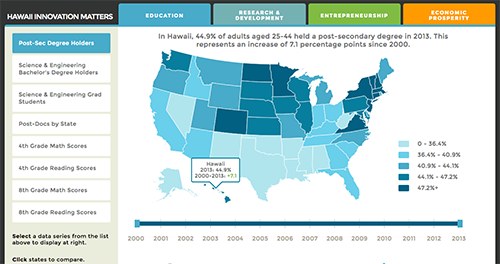By Carl Bonham
Innovation is the key to economic growth and prosperity. In the US, innovation-led productivity growth accounts for roughly half of all the increase in US GDP. And despite our increasingly connected global economy, innovation occurs at the regional level. While there is no shortage of reports that provide snapshots of Hawaii’s innovation ecosystem, or that catalog innovation assets at a point in time 1, it is important to be able to track our progress over time and to see how Hawaii stacks up against other states and localities. After all, as they say, what gets measured gets done.
UHERO’s Hawaii Innovation Matters dashboard 2 is our first attempt to provide a common set of statistics to facilitate research driven dialogue on the important topic of innovation and regional economic development. Innovation is more than scientific discovery or coming up with new ideas. It connects knowledge, assets, and networks to create both new products and new methods of creating goods and services to sustain global competitive advantage. As a result, the Hawaii Innovation dashboard covers a range of indicators suggested by the Council on Competitiveness report on Measuring Regional Innovation. Below I provide a short description of a few of the metrics we track in the areas of Education, Research & Development, Entrepreneurship, and Economic Prosperity.

Talented people are the source of innovation, and harnessing the talents of a skilled workforce is a necessary ingredient for economic growth. Hawaii Innovation Matters tracks measures of human capital ranging from secondary math and reading scores to the share of young adults with college degrees or college graduates with STEM degrees. Equally important are our investments in research and development (R&D). We track key measures of academic and business R&D, as well as outcomes in the form of patents, University startups and technology licenses.
Inputs to the innovation process must also be matched by entrepreneurial capacity and effort. New and young businesses are the primary source of net new jobs 3, so we report statistics on the share of jobs in startup firms, their survival rates, and venture capital funding. Finally, the end goal of research, development and innovation is higher productivity, rising standards of living and, ultimately, increasing well-being of Hawaii’s people. Here, we assess Hawaii’s progress by comparing per capita gross domestic product for Hawaii, other states and the nation, along with key measures of labor force activity and regional price parities.
As you explore Hawaii’s performance and progress in Education, R&D, Entrepreneurship, and Economic Prosperity, I hope you will learn something new and reach out with your comments. We welcome your input and feedback as we work to track what matters for innovation.
BLOG POSTS ARE PRELIMINARY MATERIALS CIRCULATED TO STIMULATE DISCUSSION AND CRITICAL COMMENT. THE VIEWS EXPRESSED ARE THOSE OF THE INDIVIDUAL AUTHORS. WHILE BLOG POSTS BENEFIT FROM ACTIVE UHERO DISCUSSION, THEY HAVE NOT UNDERGONE FORMAL ACADEMIC PEER REVIEW.
[1] See The Evolution of the Hawaii Growth Initiative (2016), Hawaii Innovation Assets Report (2015), The Innovation Framework Forward (2014).
[2] Hawaii Innovation Matters is supported by the Hawaii Business Roundtable, the University of Hawaii Office of the Vice President of Research and Innovation, and DevLeague.
[3] Haltiwanger, Jarmin, and Miranda (2010), “Who Creates Jobs? Small vs. Large vs. Young,” NBER Working Paper 16300; Kane (2010), “The Importance of Startups in Job Creation and Job Destruction,” Kauffman Foundation; and Haltiwanger, Jarmin.